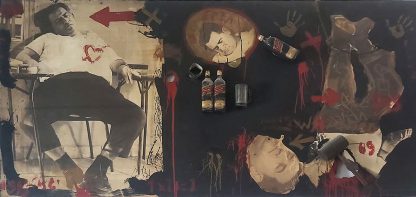
In memory of the most influential & controversial artist in the history of Israeli art
Igal Tumarkin October 1933 - 2021,
The painter and sculptor Yigal Tumarkin, winner of the Israel Prize, passed away at the age of 87.
Tumarkin was one of the most prominent artists in Israel, and was known for his paintings and his outdoor sculptures and monuments. Over the years he has won many awards for his work in Israel and around the world.
The Farkash Gallery Offer for sale the most iconic painting and one of the most important works by the artist Yigal Tumarkin in the history of Tel Aviv and Israeli art in general. This work was hanging on the mythological Kassit coffee in Tel Aviv
For More Details Click Here
Cafe Kassit
The cafe was first established in 1935 by Ezekiel Weinstein (later known as Hazkel Ish Kasit), Yuva Goldberg and Ilona Mordechowitz. His famous envoys include Natan Alterman, Avraham Shlonsky, Yabi, Uri Lifshitz, Shmulik Krauss, Leah Goldberg, Chaim Guri, Moshe Shamir, Natan Zach, Hannah Rubina, Alexander Penn, Yosef Zaritzky, Moshe Bernstein, Avot Yeshurun, Zeev Yosifon, Binyamin Gon, Hanna Maron and Yaakov Rechter, the Lul group (led by Uri Zohar and Arik Einstein) and “Huna” with the biggest shoes. In the 1950s, there was a special wing reserved for members of the “Parliament of Kassit”.
Just for the curiosity
According to the stories, the artist Yigal Tumarkin was in constant quarrels with Hazkel, the owner of the Kassit cafe.
1960–1970: “The Art of Protest”
In 1960, Tumarkin returned to Israel with the encouragement of Danziger, Yona Fischer and Sam Dubiner to “do an exhibition at Bezalel, and then return,” [13] but remained in Israel for another two years. In 1961, Tumarkin’s first solo exhibition in Israel opened at the Bezalel Disability Center. Tumarkin wrote that he came from Paris “with the gospel of the object and the assemblage, the same poetic garbage that was not known and accepted in the land of the lyrical abstract.”
In the works he created, the influence of pop art and avant-garde protest art stands out. In the painting “Panic About Pants” (1961), from the famous works of the time, Tumarkin used a pair of stained work pants, painted in black, to which he added a red color. In the following years he began to sculpt in various scraps and iron, and in his words “it seems to me then that I am creating an absurdity – archeology in the present time.” In 1961 he traveled to the Negev, building models of landscape sculptures. In 1962 he traveled to Japan and the United States to learn Japanese painting techniques.
Monumental sculptures created by Tumarkin during this period, such as The Arad Lookout (1962–1968), are an exception to his figurative approach at the time. This approach to design was typical of most of the monuments he sculpted in the 1960s. In its design, the monument symbolizes and shapes a human experience in the landscape, “not only in its form and materials, but also in its location (it represents) the entirety of the context.” [16] However, Tumarkin retained the expressive language in the design of the structure and composition.
In 1964, Tumarkin received a damaged weapon that had been taken out of the IDF weighing a ton, from which he created forty assemblage sculptures during five months in his studio, which was then located in Kiryat Hamelacha in Tel Aviv. September 22. “When I create a statue of a broken weapon,” Tumarkin claimed in a press interview, “there is something daunting about that. We keep claiming that we have turned to peace and we cringe at the verse “and his sword shall fall on them” – well, that’s the line that guides me. ” In the sculpture “Put Me Under Your Wing” (1964–1965), Tumarkin created a kind of iron shell from which rifle butts emerge. A similar approach stands out in the creation of his well-known sculpture “He Walked in the Fields” (1967).
Among the main exhibitions that Tumarkin presented during this period are: the exhibition “Gnesters” (1967) at the Gordon Gallery, “The Portrait of the Artist as a Young Man” (1968) at the Tel Aviv Museum, and more. Following the great success of his exhibitions, Tumarkin won the “Sandberg Prize” from the Israel Museum in 1968 together with the painter Arie Aroch. This was the second time that the prize was awarded, and the statue “Lights and Tomes” was purchased by the museum.
The group of sculptors known as the “Astronauts”, created in the late 1960s, is a transition from the expressive nature of his early work in which “his warriors were converted into astronauts, scrap – in nickel-plated polished welds, and the expressionist seizure of the For a time, most of them were female figures, using mannequin mannequins on top of which Tumarkin designed a kind of large ornate hats in a surrealistic spirit.
